{{{description}}}
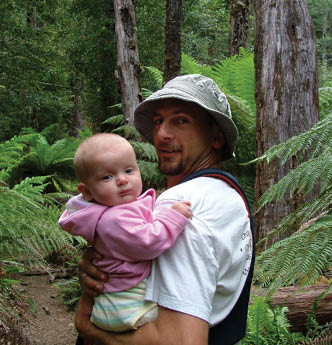
Sophie (3 years old) trying on Dad’s boots and hat, BP Lodge, Cradle Mountain
First family bushwalk to Oxley Falls. Sophie (4 months)
Sophie (7 years old) and Ruth (5 years old), Horse Track, Cradle Mountain
Of course the first question to consider is whether people should be taking babies bushwalking at all. There’s an element of risk in bushwalking and babies won’t gain much from the experience. However, leaving a breast-feeding baby with a baby-sitter for three days is not a good option (although it may be possible if you’re rigorous with your breast-pumping and freezing routine, and your baby is used to the bottle). Alternatively, husbands could leave the wife at home with the baby and go alone or with other friends, which is not much fun for the wife. But there is something very special about doing the things you love with the people you love and Heidi is the person I most like to have with me when camping in the middle of nowhere. There is also something special about having the whole family together on an adventure.
Taking babies or young children on overnight bushwalks adds a whole new level of complexity to planning and logistics. It makes every element of danger even more dangerous. It makes every weary step more difficult. It makes the already heavy pack heavier and the sore shoulders more painful. But despite these increased difficulties, some parents still feel the strong and urgent pull of the bush and decide that it’s worth it so that the whole family can spend some time out bush together. With careful planning and preparation it can be done, but safety must come first, and some expectations must be very much reduced.
Our first family bushwalk was when our first daughter Sophie was four months old - a short easy day walk to Oxley Falls, half way along the Lees Paddocks Track. It was exciting to be in the bush for the first time as a family and we have great memories and photos of that occasion, including of breast-feeding on the banks of the Mersey River and of the baby asleep on the rocks while we had lunch. A short day walk with one small baby between two adults was quite easy for us, and it was encouraging to know that we could still do the things we love with a baby.
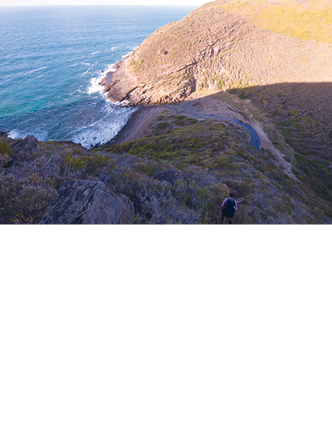

BWA October 2015 | 67


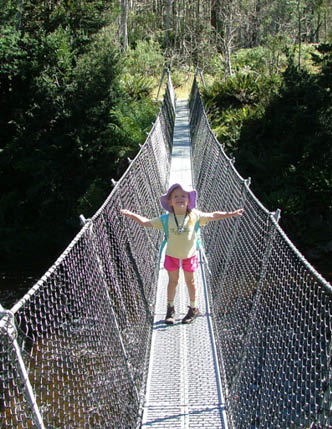
Sophie (4 years old) proud of her bushwalking T-shirt and head torch, Lees Paddocks Track
Conquering the Rock. Overland Track, en route Horse Track and BP Lodge
Sophie (8 years old) and Ruth (6 years old) taking in the view at Lady Lake Hut
It was another two years and daughter later that we attempted our first pack-carrying overnight walk with Sophie and Ruth. I had listened carefully to advice from people who’d been bushwalking with babies and it sounded rather daunting. In particular, the issue that I’d heard most often was that you simply cannot walk anywhere near as far as you think you can. It was difficult to grasp the full reality of this, but I made it a primary consideration when planning our first such walk. And I’m so very grateful that I did!
For our first overnight bushwalk with kids, we hired the Baden Powell Memorial Lodge at Cradle Mountain for two nights and we asked a couple of friends to come along with us.
This is a well equipped private hut towards the top of the Cradle plateau. It has water on tap, a fully-equipped kitchen, several bunk beds and even a flushing toilet. We knew that we’d have to carry a lot of extra items for kids that we were not used to carrying so staying at this hut meant we could avoid carrying camping gear.
However, the most significant advantage of using this hut was that it was a very short walk from the cars, 45 minutes recommended, 30 minutes for fast walkers. This turned out to be about the right distance for us. The first half of the walk is quite flat, and the rest is moderately steep uphill. It took us nearly two hours of painful walking,
68 | BWA October 2015
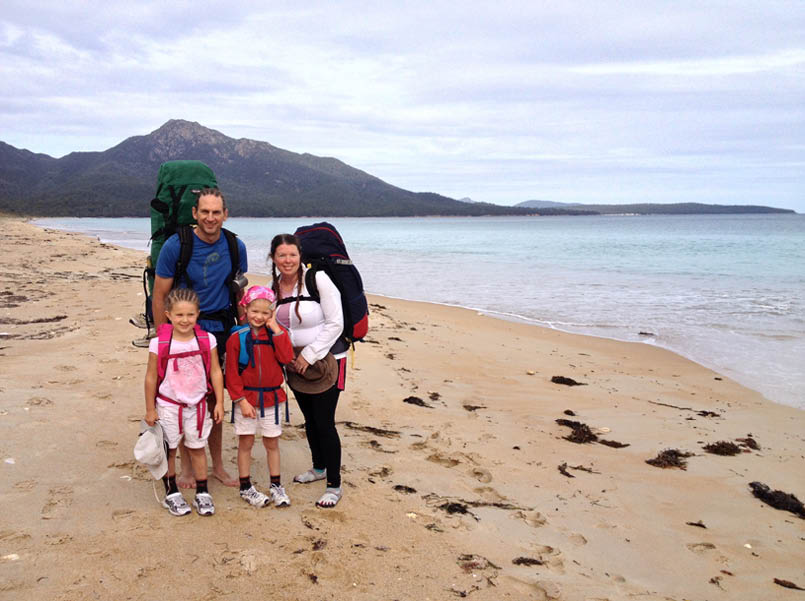
feeling like pack horses the entire way. That was much longer that I’d anticipated and we were thoroughly exhausted when we arrived. This was partly because we were out of condition, but largely because of the extra difficulty in carrying kids and all the gear that kids require.
We’d been told again and again how difficult it would be, but it’s not until you experience it that you can fully comprehend it. Mind you, we were doing this with two kids, not just one, so that was even more difficult. Think about the logistics. When you go on an overnight bushwalk you have a fairly full back pack, and you generally feel that you would not want to carry much more than that. Add to that all the extra things that an extra two people need. You think that’s bad enough? Now add the weight of the extra two people themselves! Kids are heavy!
Here is a list of some of the extra gear that we’ve carried for bushwalking with babies or kids:
Portacot - we have a brand that packs down to a similar size and weight as a tent.
Baby wipes - these vary a lot in quality and there’s only one brand that we consider to be any good.
Nappy bags - use separate bags for dirty knickers/undies and dirty wipes so that when you get home you don’t have to try to separate several days-worth of this mess.
Nappies - at home we use cloth nappies most of the time, but certainly not when bushwalking - for the babies I mean, not the adults
Poo & wee - you can’t leave those used disposable nappies in the bush.
Nik, Heidi, Ruth and Sophie on Hazards Beach, Freycinet Peninsula
“You may think that a portacot is a bit of overkill, but it was excellent for this first trip.

BWA October 2015 | 69
Emptied baby wipes bags - highly recommended to buy good-brand wipes in bulk, and never throw out the zip lock bags they come in; they are super-tough and can hold many dirty nappies.
Antiseptic hand wash - some people always carry this bushwalking, but when changing nappies several times a day it’s even more of a good idea.
Toilet seat - if your kids are toilet training, squatting over a hole in the ground can be tricky for them; a comfy toilet seat on the ground can help.
Teddy bear - for kids who are a bit older than babies
You may think that a portacot is a bit of overkill, but it was excellent for this first trip. It meant that Ruth, at four months old, could go to bed in the next room where her crying would not keep us awake, and we’d know that she’d be safe in the portacot. Unlike the huge heavy rectangular ones that many people use, our portacot packs very small and is quite light to carry.
Now, how do you carry all of this additional equipment, plus the kids themselves, as well as all of your usual gear? Well, I’d got an idea from a bushwalk a few years earlier when my brother injured his knee and we all took turns in carrying his pack, as well as our own - two packs, one on the back and one on the front - so that he could hobble out using an improvised crutch. The front pack was not as full as the back pack so that you could at least see over it a little. This is what I decided to do for our first overnighter with babies. Heidi carried two kids, Sophie on her back, and Ruth on the front, and I carried two packs. On the way out we carried a pack and a child each.
It turns out that this was a very bad idea! I strongly recommend against it. In hindsight, it would have been better to have done the walk 18 months earlier, with only one baby or a year later when Sophie could walk all the way. Sure, we survived the walk
and we had a great time, but after about the first 15 minutes or so the walking was most unpleasant. It was also quite difficult to see where I was putting my feet due to the large front pack obscuring most of the ground. The massive strain we were putting our bodies under was very difficult for us both but especially for Heidi who is not as keen on bushwalking as me, and it was psychologically difficult for me trying to keep us motivated to keep going. The rain helped with that too.
I certainly don’t recommend taking babies bushwalking in the rain but in this case, I figured that it was a short distance to a good hut and at worst, we could easily return to the car at any time. However, I was very grateful to reach the hut safe and sound, at which point our youngest was handed into the care of the friendly hut warden while we unpacked and dried out.
The following year we did the same walk again with another family including their

Sophie (3 years old) with her friend Asha, Horse Track, en route BP Lodge
“... four adults and six kids under six years old. That was a great adventure!
“Heidi carried two kids, Sophie on her back, and Ruth on the front, and I carried two packs.

70 | BWA October 2015
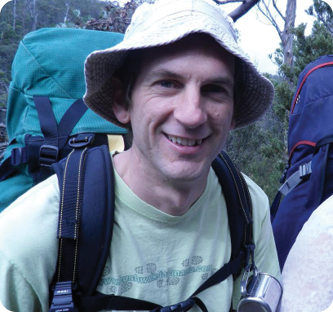

Sophie (7 years old): “My legs hurt but I feel great!”
Nik has been bushwalking for as long as he can remember, which turns out to be about 40 years. He lives near Launceston in Tasmania and has recently changed career from an IT systems admin to working with Geographic Information Systems. Nik also created Australia’s most popular bushwalking web site Bushwalk.com and developed an offline mapping and spatial data system for iOS devices. Two of his greatest personal achievements are raising two girls and rafting the Franklin river - he’s unsure which of these is more scary or more exhilarating.
four kids - four adults and six kids under six years old. That was a great adventure! The noise in that hut! Having learnt from our last experience, and having Sophie able to walk the entire distance and, Ruth not requiring a portacot, we had somewhat easier loads to carry. This made all the difference and we really were able to enjoy the actual walking this time, not just the camping - in fact I’d almost say that the exact same track was a doddle compared to the previous time. The sunny weather probably helped a bit too.
Instead of carrying two packs at once, the two Dads did double the amount of trips. This was practical simply because it was such a short distance. After everybody reached the hut, the Dads had a bite to eat and a drink and returned to the cars for their second loads. It only took us 25 minutes to get back to the cars, and then 35 minutes to reach the hut again. On the last day, we took the first packs to the car early and then returned to help clean up the hut. We walked out again with the rest of the families and our second loads.
Part two of the article will be published in December 2015 BWA.

BWA October 2015 | 71